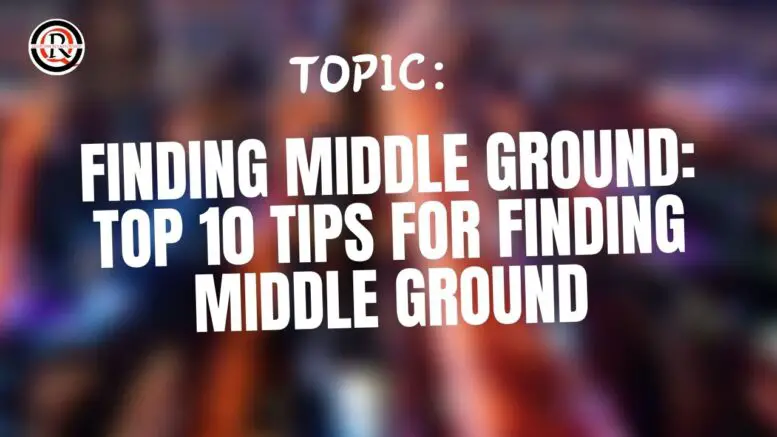What is Finding middle ground
Finding middle ground refers to the process of reaching a compromise or agreement between two parties with differing opinions or positions. It involves identifying common ground and areas of agreement to create a solution that accommodates the interests and concerns of both sides.
This concept is often applied in various contexts, such as negotiations, debates, or discussions where there is a need to reconcile conflicting viewpoints. Finding middle ground is seen as a constructive approach to problem-solving, as it encourages collaboration and mutual understanding.
In the context of interpersonal relationships, finding middle ground can also involve understanding and respecting each other’s perspectives, values, and preferences to create a harmonious and balanced relationship.
Overall, the goal of finding middle ground is to foster cooperation, reduce tension, and promote a solution that is acceptable to all parties involved. It requires open communication, empathy, and a willingness to explore alternatives that can address the concerns of both sides.
What does it mean to find a middle ground?
Finding middle ground means reaching a compromise or agreement between two opposing viewpoints, opinions, or positions. It involves identifying common elements or shared interests among conflicting parties and working towards a solution that accommodates the concerns of both sides. This process aims to avoid extreme positions and promotes a more balanced and mutually acceptable outcome.
When individuals or groups seek middle ground, they are acknowledging the diversity of perspectives and attempting to find a reasonable and fair resolution that meets the needs of everyone involved. It often requires open communication, negotiation, and a willingness to understand and respect different points of view.
Finding middle ground is a constructive approach to conflict resolution and problem-solving. It helps foster cooperation, build relationships, and create a sense of unity despite differences. In various contexts, such as politics, business, or personal relationships, finding middle ground is often seen as a positive and pragmatic way to address disagreements and move forward.
Which is the most effective way of finding the middle ground?
Finding the most effective way to reach a middle ground can depend on the specific context and the nature of the disagreement. However, there are some general principles and strategies that can enhance the effectiveness of finding middle ground:
- Active Listening:
Ensure that all parties actively listen to each other’s perspectives without interrupting.
Demonstrate empathy and understanding by acknowledging the validity of others’ viewpoints.
- Open Communication:
Encourage open and honest communication to create an environment where everyone feels comfortable expressing their thoughts and concerns. Clearly articulate your own position and be receptive to feedback.
- Identify Common Ground:
Focus on shared interests or goals that both parties can agree upon.
Emphasize similarities rather than differences to build a foundation for compromise.
- Be Flexible and Willing to Compromise:
Recognize that finding middle ground often involves some level of compromise from all parties.
Be open to alternative solutions and be willing to adjust your initial position.
- Seek Win-Win Solutions:
Aim for solutions that benefit all parties involved, rather than a win-lose outcome.
Look for creative and collaborative approaches that address the concerns of each side.
- Establish Clear Goals:
Define the desired outcomes and goals for the negotiation or discussion.
Clarify priorities to ensure that everyone understands what is most important to each party.
- Neutral Third Party:
In some cases, involving a neutral mediator or facilitator can help guide the conversation and find common ground.
Mediators can provide an unbiased perspective and help maintain a constructive atmosphere.
- Build Trust:
Foster trust among the involved parties by being reliable, transparent, and respectful.
Trust is crucial for creating an environment where compromise is more likely.
- Focus on the Future:
Instead of dwelling on past disagreements, concentrate on finding solutions that will benefit everyone moving forward.
A forward-looking approach can help shift the focus from blame to resolution.
- Stay Patient and Persistent:
Finding middle ground can take time, and it may require several rounds of discussion.
Stay patient and persistent in working towards a solution that is acceptable to all parties.
Remember that the effectiveness of these strategies can vary based on the specific circumstances and individuals involved. Adjusting your approach based on the unique dynamics of the situation can contribute to a more successful resolution.
How do you find the middle ground in a relationship?
Finding middle ground in a relationship is essential for maintaining harmony and resolving conflicts. Here are some strategies to help you find a balance and compromise in a relationship:
- Effective Communication:
Foster open and honest communication. Encourage your partner to express their thoughts and feelings, and actively listen to what they have to say.
Clearly articulate your own needs, concerns, and expectations.
- Empathy and Understanding:
Try to understand your partner’s perspective. Put yourself in their shoes and acknowledge their feelings and concerns.
Show empathy by validating their emotions, even if you don’t necessarily agree with their point of view.
- Identify Common Goals:
Identify shared values and goals that both of you can agree on. This can serve as a foundation for finding common ground.
Focus on the aspects of your relationship where you both have similar priorities.
- Prioritize Issues:
Recognize the importance of different issues within the relationship. Some things may be non-negotiable, while others may have room for compromise.
Prioritize what matters most to each of you and work towards finding a middle ground on those key issues.
- Negotiate and Compromise:
Be willing to give and take. Compromise is an essential part of finding middle ground.
Look for solutions that meet both of your needs, even if it means finding a middle point rather than each getting exactly what you want.
- Establish Clear Boundaries:
Clearly define and communicate your boundaries. Understand where each person’s comfort zones lie and respect those boundaries.
Establishing clear boundaries can prevent misunderstandings and conflicts.
- Take Breaks When Needed:
If discussions become heated or emotions run high, it’s okay to take a break and revisit the conversation later when both parties are calmer and more receptive to finding common ground.
- Seek Professional Help if Necessary:
If conflicts persist, consider seeking the assistance of a relationship counselor or therapist.
A neutral third party can provide guidance, facilitate communication, and help both partners understand each other better.
- Celebrate Differences:
Recognize and celebrate the uniqueness of each individual in the relationship. Embrace differences rather than seeing them as obstacles.
Appreciating and respecting each other’s individuality can contribute to a healthier relationship.
- Show Appreciation:
Express gratitude for the positive aspects of your relationship. Focusing on the things you appreciate about each other can create a more positive and cooperative atmosphere.
Remember that finding middle ground in a relationship is an ongoing process. It requires effort, patience, and a commitment to working together to create a balanced and satisfying partnership.
How do you know you found the right partner?
Determining if you’ve found the right partner involves a combination of emotional connection, compatibility, shared values, and mutual respect. Here are some signs that may indicate you’ve found the right partner:
- Compatibility:
You share common interests, values, and life goals.
Your personalities complement each other, and you feel comfortable being yourself around your partner.
- Effective Communication:
You communicate openly and honestly with each other.
Your partner listens to you, understands your perspective, and values your opinions.
- Mutual Respect:
You and your partner respect each other’s boundaries, opinions, and autonomy.
There is a genuine admiration for each other’s qualities and accomplishments.
- Emotional Connection:
You feel a deep emotional connection and a sense of intimacy with your partner. You can share your vulnerabilities without fear of judgment.
- Supportive Relationship:
Your partner is supportive during both challenging and successful times.
You encourage each other’s personal growth and development.
- Trust and Honesty:
Trust is established and maintained in the relationship. Both partners are honest and transparent with each other.
- Shared Values and Priorities:
Your core values align, providing a foundation for shared priorities in life.
You have similar views on important aspects such as family, finances, and lifestyle.
- Conflict Resolution:
Disagreements are handled constructively, with a focus on finding solutions rather than blaming each other. You both are willing to compromise and work through challenges together.
- Feeling Secure:
You feel emotionally secure and valued in the relationship.
There is a sense of trust and safety in expressing your true self.
- Long-Term Vision:
You can envision a future with your partner, and you both discuss long-term goals.
Your partner’s values align with what you see for your future together.
- Chemistry and Attraction:
There is a physical and emotional attraction between you and your partner. You enjoy spending time together and find joy in each other’s company.
- Resilience in Challenges:
The relationship can withstand challenges, and both partners are committed to working through difficulties. You grow stronger as a couple in the face of adversity.
Remember that no relationship is perfect, and it’s natural to encounter ups and downs. However, if you consistently experience these positive indicators and feel fulfilled in your relationship, it may be a sign that you’ve found the right partner for you. It’s essential to communicate openly about your feelings and expectations to ensure a healthy and satisfying partnership.
How do you know where you are in a relationship?
Determining where you are in a relationship involves assessing various factors, including emotional connection, commitment, communication, and shared goals. Here are some indicators that can help you understand the stage or status of your relationship:
- Communication:
Open and honest communication is a key sign of a healthy relationship.
Regular discussions about your feelings, expectations, and future plans can help clarify where you stand.
- Emotional Intimacy:
The level of emotional intimacy and vulnerability between you and your partner can indicate the depth of your connection.
Sharing personal thoughts, feelings, and experiences contributes to emotional closeness.
- Commitment Level:
Assess the level of commitment from both parties. Discussing exclusivity and future plans can provide clarity on the commitment aspect.
If you both express a desire for a long-term commitment, it suggests a more serious stage in the relationship.
- Shared Goals and Plans:
Discussing and aligning your future goals and plans can provide insights into the seriousness of the relationship.
If you’re making joint decisions about the future, such as living arrangements, career plans, or family goals, it may signify a deeper commitment.
- Time Together:
The amount of time you spend together and the activities you engage in can indicate the depth of your connection.
If you’re integrating into each other’s lives, meeting friends and family, and participating in shared experiences, it may suggest a more advanced stage in the relationship.
- Exclusivity:
If you have explicitly discussed and agreed upon being exclusive, it signifies a level of commitment beyond casual dating. Discussing the boundaries and expectations regarding exclusivity can help clarify where you stand.
- Comfort and Trust:
Feeling comfortable being yourself around your partner and having a high level of trust are positive indicators.
If you’re both open, trusting, and supportive of each other, it suggests a mature and stable relationship.
- Introducing to Others:
If you’ve introduced your partner to friends and family or have been introduced to theirs, it may indicate a desire for a more significant connection.
Being integrated into each other’s social circles is often a sign of a committed relationship.
- Navigating Challenges:
How you both handle challenges and conflicts can offer insights into the strength and maturity of the relationship.
Successfully navigating difficulties together is a positive sign for a resilient relationship.
- Assessment of Feelings:
Reflect on your own feelings and assess whether you see a long-term future with your partner.
Have open conversations about your emotional connection and evaluate whether you both share similar sentiments.
Note that every relationship is unique, and the pace at which it progresses can vary. Honest and open communication is crucial to understanding where you and your partner stand in the relationship. If you have uncertainties or questions, discussing them openly can provide clarity and strengthen the bond between you two.
10 Tips For Maintaining Positive Middle Ground
Maintaining positive middle ground in any relationship or situation involves ongoing effort, communication, and a commitment to finding commonality. Here are 10 tips to help you sustain a positive middle ground:
- Open and Honest Communication:
Foster an environment where communication is open, honest, and respectful.
Encourage dialogue about feelings, concerns, and expectations to avoid misunderstandings.
- Active Listening:
Practice active listening to truly understand the perspectives and needs of all parties involved.
Demonstrate empathy by acknowledging and validating the feelings and opinions of others.
- Seek Common Ground:
Continuously look for shared interests, values, or goals that can serve as a foundation for compromise.
Focus on what unites you rather than what divides you.
- Flexibility and Adaptability:
Be open to flexibility and adaptability in your approach and opinions.
Recognize that finding middle ground often involves adjusting expectations and being willing to meet in the middle.
- Positive Attitude:
Maintain a positive attitude even when facing challenges.
Approach disagreements with a constructive mindset, seeking solutions rather than dwelling on problems.
- Respect Differences:
Embrace and respect the differences between individuals or parties.
Appreciate diversity and recognize that everyone may have unique perspectives and preferences.
- Establish Clear Boundaries:
Clearly define and communicate boundaries to ensure that all parties feel comfortable and respected.
Understanding each other’s limits helps prevent conflicts.
- Regular Check-Ins:
Schedule regular check-ins to discuss the state of the relationship or the situation.
Use these check-ins as opportunities to address concerns, celebrate successes, and recalibrate if necessary.
- Shared Responsibilities:
Distribute responsibilities and tasks fairly to promote a sense of equity and shared commitment.
Collaborate on decisions and actions, avoiding situations where one party feels burdened.
- Celebrate Achievements:
Acknowledge and celebrate achievements and positive moments, both big and small.
Positive reinforcement helps strengthen the bond and encourages a continued focus on shared goals.
Remember that maintaining positive middle ground is an ongoing process that requires effort and commitment from all parties involved. Regularly reassessing and adapting your approach based on changing circumstances can contribute to a resilient and harmonious relationship or collaborative effort.
Conclusion
In conclusion, understanding the dynamics and status of a relationship involves a multifaceted assessment of various factors. Communication, emotional intimacy, commitment level, shared goals, time spent together, exclusivity, comfort, trust, social integration, and the ability to navigate challenges all contribute to the overall picture of a relationship.
Successful relationships often require open and honest communication, mutual respect, and a willingness to address challenges together. It’s essential to be attuned to the feelings and expectations of both partners, fostering an environment of trust and understanding. While each relationship is unique, certain indicators such as shared values, effective communication, and a sense of commitment can help guide individuals in assessing where they are in their relationships.
Remember that relationships evolve over time, and it’s natural for them to progress through different stages. Continual communication and a shared vision for the future can contribute to a healthy and fulfilling partnership. If there are uncertainties or concerns, addressing them openly with your partner can lead to a deeper understanding and strengthen the connection between you two.






Be the first to comment on "Finding Middle Ground: Top 10 Tips for Finding Middle Ground"